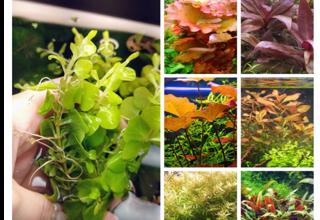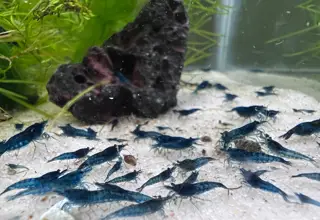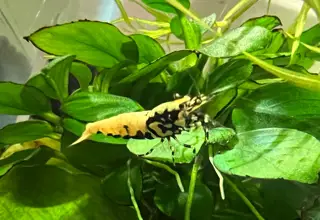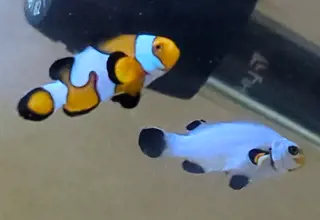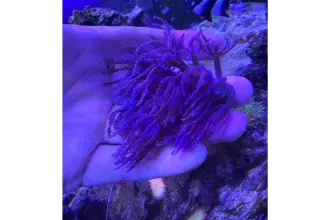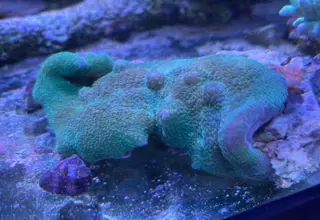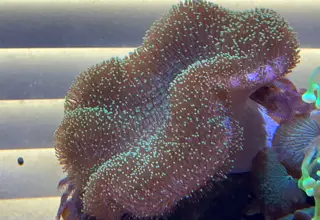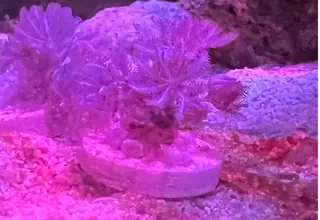Gem Tang: Pricing, Care, Reef Compatibility & More
Posted by on 3/24/2023
We use affiliate links and may receive a small commission on purchases.
Known as one of the most expensive fish in the saltwater aquarium hobby, the Gem Tang is an attractive and eye-catching fish that is sure to catch the attention of those fortunate enough to witness one in person.
While these fish are often sought after for their appearance, purchasing a Gem Tang is a big investment, and you'll want to provide the best care possible so that you can experience all that this fish has to offer. In this post, we'll cover a lot of information about gem tangs. We'll discuss the appearance of some new related hybrids, we'll give an overview of why they are so expensive, and we'll also provide recommendations on their care requirements.
Table of Contents
Species Summary
The Gem Tang (scientific name: Zebrasoma gemmatum) is a rare marine tang native to the Western Indian Ocean, where it swims off the coasts of the Réunion and Mauritius islands, Mozambique, South Africa, and Madagascar.
First scientifically classified by French zoologist Achille Valenciennes , the Gem Tang typically lives a solitary lifestyle, where it inhibits reefs 30-200 feet below the ocean's surface. Similar to other tangs, they can exhibit territorial behaviors but can adapt to a captive lifestyle in an at-home aquarium.

Pricing
Gem tangs can sell from anywhere between $300-$3000 per fish.
Gem tangs have a reputation for being one of the most expensive species in the saltwater aquarium hobby. While the prices of these fish have been known to change over time, there are quite a few factors that lead to their high price.
South Africa has strict requirements surrounding the export of ornamental fish, so that rules out gem tangs from this region. Madagascar and Mozambique simply don't have the gem tang populations to make the export of the species worthwhile.
Mauritius is where the majority of these fish come from, and Meneeka Gurroby, owner of Ornamental Marine World is the primary exporter of these unique-looking fish.
Once you add external costs such as shipping, prices skyrocket.
Appearance
Gem Tangs share a disc-like shape that's similar to other Zebrasomma species. An elongated snout is followed by dark black eyes, but it is the fish's all-black body, covered in silver dots that resemble small gemstones that make the fish highly sought after.
The coloration of the fish extends into its dorsal, anal, and pelvic fins. Gem tangs feature translucent pectoral fins, while their caudal fins feature an opaque yellow and pearl coloration.

Barcode Gem Tang vs Gem Tang
Hobbyists already familiar with the gem tang may be surprised to hear that an additional variation exists, known as the Barcode Gem Tang.
The fish is nearly identical to the gem tang, with the only exception being its horizontal white lines, which replace the small dots along the midsection of the fish's body.
Hobbyists interested in seeing the appearance of this fish should check out Reefbuilder's excellent post describing the species.
Zebrasoma Gemmatum vs Zebrasoma gemmatum x Z. scopas
As of 2015, a new hybrid Gem Tang has emerged, known as Zebrasoma gemmatum x Z. scopas. This hybrid species is a crossbreed between the scopas tang and the gem tang and features numerous small dots when compared to the traditional gem tang.
Reefbuilder's covers the species in more detail , for those that are interested in learning a bit more about this hybrid.
Size
Gem tangs are relatively small fish and typically range between 7-9 inches in length.
Males and females are typically the same size and are virtually indistinguishable. As with most fish, a well-balanced diet is one of the biggest factors in helping a juvenile gem tang reach its full adult length.
Gem Tang Care
If you're the proud owner of a gem tang, or you're considering purchasing one, you'll want to provide the highest level of care possible. Not only is a gem tang an expensive fish but it will also likely be considered a prized possession for hobbyists fortunate enough to own one.
Luckily for hobbyists, tangs, including the gem tang, aren't too picky when it comes to tank requirements. Still, you'll want to be well-versed in their care so that you can prevent problems before they occur.
Lifespan
Gem Tangs are a long-lived species and have an average lifespan of about 10 years in captivity.
This is typical for most Zebrasoma species, which tend to average about 10 years in an aquarium, and 30 years in the wild.
Providing the best care possible, combined with a nutrient-rich diet will result in longer life expectancies.
Tank Size
At a minimum, you'll need at least a 180-gallon tank if you plan on housing a Gem tang.
These fish need plenty of places to roam, and a smaller tank does not work well with the unpredictable territorial behavior we see in Zebrasoma species.
More adventurous hobbyists looking to house multiple species of tangs in one tank will need an even larger aquarium. Tanks in the 500-gallon range are not unheard of for a tank housing multiple Zebrasoma fish, but you should have a strong understanding of the risks before taking on this challenge.
Acclimation
As a best practice, we always recommend quarantining new tank additions to prevent diseases such as marine velvet from taking hold.
However, if you're willing to risk introducing any potential diseases, and you trust the vendor's water source, you can float the gem tang bag in your tank water for around 15 minutes so that temperatures begin to align. Then you can add small amounts of tank water (about ⅓ the volume of the bag the gem tang is shipped in), 3 times over 45 minutes. Once you've finished, the fish should be acclimated to your display tank's water conditions and can be released into the aquarium.
Drip Acclimation
The safest acclimation method is known as drip acclimation, and this method may be the most attractive for gem tang owners, due to the fish's high cost.
To perform a drip acclimation, you'll want to release the tang into a bucket with the shipped bag water. Over the next 2 hours, you'll want to slowly drip water from your display tank into the bucket. A drip acclimation kit can make the process a bit easier.
After the 2 hours end, your fish can be released into your display tank.
Water Conditions
You'll want to re-create the reef conditions of these fish's native habitat as closely as possible. Unsurprisingly, gem tangs share the same water parameter requirements as other saltwater aquarium fish.
Maintaining the following for the duration of your Gem Tang's life will allow it to reach its full life expectancy.
Specific Gravity: 1.020-1.025
Temperature Range: 72°F-78°F
KH: 8-12 dKH
pH: 8.1-8.4
Ammonia: 0ppm
Nitrite: < .2ppm
Nitrate: 5-10ppm
Gem Tangs are considered a hardy fish, but you'll still want to frequently test your water, using reliable test kits, such as those from Hanna .
Tank Setup
Gem Tangs prefer high levels of flow, so we recommend adding adjustable powerheads, such as those from ecotech marine . Plenty of live rock will create ample amounts of surface area for algae to grow, a key component to a Gem Tang's herbivorous diet.
Plenty of open space for swimming, a reliable aquarium heater , and a sump with or without a refugium will be beneficial in maintaining water quality.
Tangs aren't very picky when it comes to the substrate, while the most common substrates are sand, some hobbyists have even kept tangs in bare-bottom tanks.
Common Diseases
While tangs do have a slime coat, it's not nearly as thick of a coat seen in other species, such as the christmas wrasse or snowflake clownfish. Their thin coat makes them vulnerable to some of the more commonly seen diseases in the marine aquarium hobby, such as marine velvet, and ich. While we won't cover the symptoms and treatments in this post, we discuss it in more detail in another one of our blog posts: Marine Velvet vs Ich: Similarities, Differences, Causes & Treatment.
We strongly recommend maintaining a fully cycled quarantine tank, so that you can treat any infected inhabitants at a moment's notice. We also suggest quarantining any new tank additions, so that you can prevent these common diseases from taking hold.
Reef Compatibility
Reef enthusiasts will be pleased to know that the Gem Tang is considered reef safe, opening up a variety of different coral additions.
Blastos, chalices, and torches all can co-exist comfortably with a Gem Tang. Slower growing corals, such as some of the brain coral species will also work well.
For hobbyists interested in keeping anemones, such as the black widow, there should be no issues when paired with a Gem Tang.
Food & Diet
Gem Tangs are big eaters and should be fed a diet consisting of nori, mysis shrimp, brine shrimp, and nutrient-rich pellet foods 1-2 times per day.
Feed no more than what they can consume over 5 minutes. Gem tangs will also readily consume any available algae present in the aquarium.
Behavior and Temperament
Gem Tangs are generally active swimmers, often hanging out near the middle of the water column. They have a somewhat inquisitive nature, often examining live rock for new signs of algae growth.
Gem tangs may show aggressive behavior towards other tangs that may be introduced into their aquariums. The behavior is often unpredictable and varies between individual fish. For hobbyists set on keeping multiple tang species in one aquarium, provided they have a large enough tank, all tang species should be introduced at the same time, so that territories can be established in unison.
Tank Mates
Gem tangs are considered peaceful community fish, and co-exist with a large variety of marine fish.
Some potential tank mate options include:
Avoid highly aggressive species, such as the Tessalata Eel. Since it's difficult to discern the difference between male and female gem tangs, you'll want to avoid adding any additional gem tangs to your aquarium. As we've previously mentioned, other tang species, such as the Kole Yellow Eye and Blond Naso can coexist with a gem tang, as long as they're introduced into a large enough aquarium at the same time.
Breeding
Unfortunately, there have been no reports of Gem Tangs being successfully bred in captivity. However, we've recently seen captive-bred offerings of the Yellow Tang from biota.
Hopefully, this research will pave the way for scientists and hobbyists to create captive-bred gem tangs, which promotes sustainability and makes the species more readily available for potential hobbyists.
Where to Purchase
Hobbyists looking to purchase a Gem Tang should check their availability on our marketplace. These fish also occasionally go up for sale at some of the larger online vendors, and can be found on other popular marketplaces such as eBay .
Those looking to purchase these fish directly from the islands of Mauritius should consider reaching out to Ornamental Marine Fish .
Conclusion
As you can see, the Gem Tang is an expensive but rewarding marine aquarium fish. For many, the Gem Tang is considered a dream fish, but few have the cash for such an expensive investment.
Now that we've covered the Gem Tang's care in detail, do you plan on pursuing this dazzling fish? Let us know in the comments below, and be sure to check out our marketplace and community forum, where you can connect with other hobbyists.
